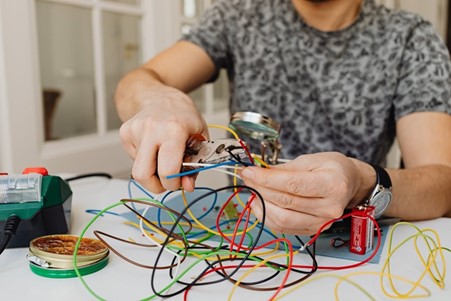
Electrician Safety: The Essential Guide to Preventing Electrical Accidents
In every profession, safety should be a top priority, but in the field of electrical work, it’s an absolute necessity. Electrician safety encompasses a broad range of practices, from understanding potential hazards to using the appropriate safety gear. This article will delve deep into the world of electrician safety and provide you with all the necessary knowledge to prevent electrical accidents.
Understanding the Risks: Common Electrical Hazards
Electrical work is fraught with potential dangers, making electrician safety paramount. Common electrical hazards include electric shock, burns, and falls caused by unexpected contact with electricity. Electrocution is also a risk, particularly when working with high-voltage systems. An awareness of these hazards is the first step towards preventing accidents.
Preventing Electrical Accidents: Best Practices for Electricians
Electrician safety relies heavily on best practices that should be followed at all times. These include turning off power sources before working on them, using insulated tools, double-checking all work, and never working on electrical systems in wet conditions. Regular equipment maintenance is also crucial in preventing electrical accidents.
Safety Gear: Essential Equipment for Electricians
No discussion about electrician safety would be complete without focusing on safety gear. Essential items include insulated gloves, safety glasses or face shields, flame-resistant clothing, and sturdy boots with non-conductive soles. Such gear provides a vital layer of protection against electrical hazards.
Safety Regulations for Electricians: What You Need to Know
Safety regulations are in place to protect electricians and ensure that they’re employing best practices on the job. Familiarity with standards like the National Electrical Code (NEC) in the U.S., or the relevant local guidelines, is crucial. These regulations cover everything from installation methods to safety procedures and are regularly updated to reflect new information and technologies.
Electrician Training: The Role of Education in Safety
Training plays a vital role in electrician safety. It’s here that electricians learn about potential hazards, safety regulations, and best practices. Moreover, ongoing education is necessary due to the evolving nature of electrical work and the continual development of new safety techniques and equipment.
Understanding the Risks:
A detailed exploration of the hazards electricians face daily. Discuss potential threats like electrical shocks, burns, falls, and repetitive motion injuries. Use data and anecdotes to provide a realistic picture of these risks.
Essential Safety Gear:
An in-depth review of the personal protective equipment (PPE) that every electrician must have. Include visuals where possible to aid understanding. Cover items such as insulated gloves, safety glasses, hard hats, and flame-resistant clothing.
Safety Protocols & Guidelines:
Outline key safety protocols and guidelines that electricians must adhere to, based on Australian standards. Discuss proper tool handling, lockout/tagout procedures, working at heights, and working in confined spaces.
Training for Safety:
Discuss the importance of regular safety training for electricians. Highlight Australian training programs, certifications, and ongoing educational opportunities.
Safety in Different Work Environments:
Compare the safety measures needed in residential, commercial, and industrial settings. Discuss specific challenges and precautions for each.
Case Studies:
Include a few case studies showing the impact of following or neglecting safety measures. These real-life examples will help to drive home the importance of safety.
Legal Implications:
Discuss the legal implications of not adhering to safety guidelines, including potential fines, litigation, and impact on insurance.
Final Thoughts: Emphasizing Electrician Safety
In conclusion, electrician safety is a multifaceted issue that requires a comprehensive approach. Understanding potential hazards, adhering to best practices, using appropriate safety gear, complying with regulations, and pursuing ongoing education are all essential for preventing electrical accidents. By taking these steps, we can ensure a safer environment for all electricians, ultimately protecting their lives and wellbeing.
Remember, when it comes to electrician safety, there’s no such thing as being too cautious. Every precaution taken is a potential disaster averted. As the saying goes, “It’s better to be safe than sorry.”





